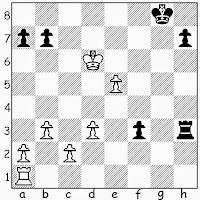1.e4 e5 2.Nf3 Nc6 3.Bc4 Bc5 4.Bxf7+ ...and related lines
(risky/nonrisky lines, tactics & psychology for fast, exciting play)
Friday, December 20, 2013
A New Jerome Gambit Player (Part 2)
Steve Wall is back with another investigation into the Jerome Gambit.
Wall,S - Guest658246
PlayChess.com, 2013
1.e4 e5 2.Nf3 Nc6 3.Bc4 Bc5 4.Bxf7+
4...Kxf7 5.Nxe5+ Nxe5 6.Qh5+ g6 7.Qxe5 Bxf2+
Just about everyone who plays the Jerome Gambit faces this "bail out" variation at one point or another. Black manages to exchange Queens at the cost of returning a piece, and with the prospect of playing on, a pawn down. White can no longer play "his" attack; but he also no longer has an "objectively" lost game.
White, in The Database, scores 69% across 90 games.
8.Kxf2 Qf6+ 9.Qxf6+ Nxf6 10.Nc3 Kg7
Surprisingly - for such a reasonable move - Black's last is the first example in The Database.
11.d3 Rf8 12.Ke2 d6 13.h3 Nh5 14.Kd1 Ng3 15.Rg1 Bd7 16.b3 Rf7 17.Bb2 Kg8 18.Nd5 Raf8
19.Nxc7 Rf1+ 20.Rxf1 Rxf1+ 21.Kd2 Rf2+ 22.Kc3 Ne2+ 23.Kc4 Rxg2 24.Kd5 Nf4+
White's material advantage and better developed King make the difference.
25.Kxd6 Bxh3
The alternative capture, 25...Rxc2 26.Kxd7 Rxb2 allows 27.d4, and White's center pawns will cost Black his Knight. Still, it would probably have been a stronger defense.
26.Be5 g5 27.Bxf4 gxf4 28.Nd5 f3 29.Nf4 Rg3 30.Nxh3 Rxh3 31.e5
Darn those Jerome pawns!
31...f2 32.Rf1 Rf3 33.e6 Kf8 34.Kd7 Black resigned








No comments:
Post a Comment